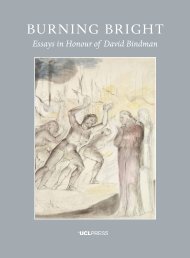Archives
TiL0x
TiL0x
You also want an ePaper? Increase the reach of your titles
YUMPU automatically turns print PDFs into web optimized ePapers that Google loves.
In many ways, this is surprising. There are plenty of clues to be<br />
found in Constantijn’s early poems revealing the extent of his selfconscious<br />
efforts towards appropriate presentation of himself and his<br />
emotions for success in public life at this time. Thus, for example,<br />
Jan Bloemendal and Ad Leerintveld have elegantly excavated the<br />
way he uses contemporary, typically Dutch emblem books, such as<br />
Otto Vaenius’s Amorum Emblemata, to construct a highly wrought,<br />
conventionally recognisable version of the emotional bond between<br />
himself and the ‘girl next door’, Dorothea van Dorp, as a virtuous<br />
friendship, in his January 1619 poem ‘Is ‘t quelling sonder maet’. 3 Each<br />
stanza of that poem – which he may have presented in manuscript as a<br />
gift to Dorothea – is contrived from a carefully chosen emblem, so as to<br />
craft and locate their feelings for one another into a form identifiable<br />
within a well-understood contemporary context, thereby proposing<br />
a passionate commitment directed towards spiritual and intellectual,<br />
rather than worldly (let alone carnal) goals.<br />
Bloemendal and Leerintveld prefer not to reach a conclusion as<br />
to the motive behind Huygens’s flamboyantly erudite verses. I suggest<br />
that ‘Is ’t quelling sonder maet’ is a well-executed example, carefully<br />
matched to contemporary expectations (the very basis for a plausible<br />
self-fashioning) for the consumption of those around the pair who might<br />
remark on their intimacy, of the poetic re-presentation of an actual love<br />
affair as a conventional, appropriately chaste, morally admirable and<br />
decorous, socially acceptable literary relationship.<br />
Although not a reliable source of the ‘facts’ behind the Huygens<br />
Dorp affair, Huygens’s poetry may give us some pointers towards<br />
decoding their contemporary epistolary exchanges. The careful<br />
Dorothea van Dorp, see J. A. Alberdingk Thijm, ‘Constantin Huygens en de familie van<br />
Dorp’, De Dietsche Warande (1864) 465–89, and ‘Constantin Huygens. Onuitgegeven Hss.<br />
en nadere letterkundige bizonderheden. Nog iets over Dorothea van Dorp’, De Dietsche<br />
Warande (1869) 477–82; J. A. Worp, ‘Brieven van Constantijn Huygens aan Dorothea<br />
van Dorp’, De Dietsche Warande (1892) 335–44; F. L. Zwaan, ‘Huygens en Dorothea’,<br />
Tijdschrift voor Nederlandse Taal- en Letterkunde 98 (1982) 131–6; E. Keesing, Het volk<br />
met lange rokken. Vrouwen rondom Constantijn Huygens (Amsterdam: Querido, 1987)<br />
and ‘Hoe is het met Dorothée van Dorp verder gegaan?’, De Zeventiende Eeuw 3 (1987),<br />
115–24. On Dorothea van Dorp, see J. M. L. Lechanteur: ‘Dorp, Dorothea van’, in Digitaal<br />
Vrouwenlexicon van Nederland, http://www.inghist.nl/Onderzoek/Projecten/DVN/<br />
lemmata/data/DorotheavanDorp.<br />
3 J. Bloemendal and A. Leerintveld, ‘De “Literaire” vriendschap tussen Constantijn Huygens<br />
en Dorothea van Dorp: Een verliefde jongen te rade bij een emblematicus?’, Spiegel der<br />
Letteren 47 (2005), 275–85. See also A. Leerintveld (ed.), Constantijn Huygens, Nederlandse<br />
gedichten 1614–1625. Historisch-kritische uitgave, verzorgd door Ad Leerintveld, 2 vols (Den<br />
Haag: Constantijn Huygens Instituut, 2001), Monumenta Literaria Neerlandica 12, 1–2.<br />
For a full, commented version of Vaenius’s Amorum Emblemata (1608), see the full text<br />
and transcription in the collection of online emblem books at Utrecht University: http://<br />
emblems.let.uu.nl/v1608.html.<br />
66 TEMPTATION IN THE ARCHIVES





